Search results for: 'For'
-
 Messapian column krater
Messapian column kraterExcellently preserved for a vessel of this size. From the collection of Alvin M. Cohen, artist and Washington Post Art Director.
Price: on request Marc Antony legionary Denarius from Wishanger hoard
Marc Antony legionary Denarius from Wishanger hoardLEG V or X. Found 2021 in East Hampshire, UK. The hoard is a very impressive proof of the fact that coins were in circulation for up to several centuries in the Roman era.
Price: on request Very large red figure neck amphora with thermoluminescence analysis
Very large red figure neck amphora with thermoluminescence analysisAbsolutely exceptional condition for a vase of this size (46cm), worth the exhibition in a museum. Original painting mainly preserved. From an old German collection, acquired prior to 1983 from the antiquities dealer Helmut Liebert, Krefeld, Germany.
Price: on request Greatly preserved Apulian bell krater
Greatly preserved Apulian bell kraterLarge vase in great condition. Used for watering down wine in Ancient Greece. From old German collection.
Price: on request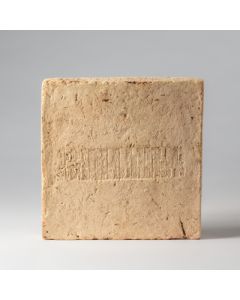 Sumerian brick with royal inscription
Sumerian brick with royal inscriptionClay tile from the temple of Eridu, donated around 2040 BC. Dedicated by Amar-Sin, king of the Third Dynasty of Ur. Studied for a research project in 1983.
€6,000 Brooch from Roman Britain
Brooch from Roman BritainThis rare variant of the T-shaped brooches was found in Lechlade, Gloucestershire. It dates to the 1st or 2nd century AR. From the famous Hattatt collection and published in two standard works for ancient fibulae.
Price: on request Luristan horse pendant
Luristan horse pendantThe spectacular creature with conjoined horse bodies is characteristic for the bronze works of Lurstian. From the early 1st Millenium BC.
Price: on request Large Luristan horse pendant
Large Luristan horse pendantThe spectacular creature with conjoined horse bodies is characteristic for the bronze works of Luristan. From the early 1st Millenium BC.
Price: on request Roman Republican denarius of Renius from Wishanger hoard
Roman Republican denarius of Renius from Wishanger hoardBiga driven by goats on reverse. Found 2021 in East Hampshire, UK. The hoard is a very impressive proof of the fact that coins were in circulation for up to several centuries in the Roman era.
Price: on request Roman Republican denarius with galley from Wishanger hoard
Roman Republican denarius with galley from Wishanger hoardObverse showing janiform heads of the Dioscuri. Found 2021 in East Hampshire, UK. The hoard is a very impressive proof of the fact that coins were in circulation for up to several centuries in the Roman era.
Price: on request Vespasian denarius from Wishanger hoard
Vespasian denarius from Wishanger hoardBeautiful dark patina. Reverse showing yoke of oxen. Found 2021 in East Hampshire, UK. The hoard is a very impressive proof of the fact that coins were in circulation for up to several centuries in the Roman era.
Price: on request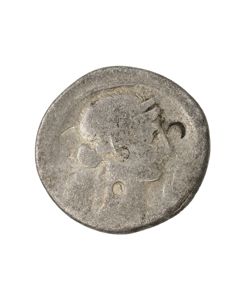 Octavian denarius from Wishanger hoard
Octavian denarius from Wishanger hoardShowing bust of Venus and Octavian in military dress. Found 2021 in East Hampshire, UK. The hoard is a very impressive proof of the fact that coins were in circulation for up to several centuries in the Roman era.
Price: on request Group of 10 Roman sestertii from Wishanger hoard
Group of 10 Roman sestertii from Wishanger hoardFound 2021 in East Hampshire, UK. The hoard is a very impressive proof of the fact that coins were in circulation for up to several centuries in the Roman era.
Price: on request Augustus denarius from Wishanger hoard
Augustus denarius from Wishanger hoardReverse showing Caius Caesar galloping right, eagle between two vexilla behind him. Found 2021 in East Hampshire, UK. The hoard is a very impressive proof of the fact that coins were in circulation for up to several centuries in the Roman era.
Price: on request Vespasian denarius from Wishanger hoard
Vespasian denarius from Wishanger hoardThe reverse shows the urn of Vespasian on a column. Great patina. Found 2021 in East Hampshire, UK. The hoard is a very impressive proof of the fact that coins were in circulation for up to several centuries in the Roman era.
Price: on request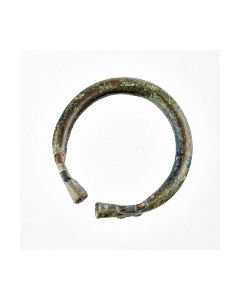 Bracelet from Luristan with animal terminals
Bracelet from Luristan with animal terminalsA high degree of abstraction for the animal heads and a wonderful blue patina make this piece a highlight for Iranian bronze works.
Price: on request Roman Republican denarius from Wishanger hoard
Roman Republican denarius from Wishanger hoardAnonymous, 2nd century BC. Found 2021 in East Hampshire, UK. Best condition of the five Marc Antony denarii in the hoard. The hoard is a very impressive proof of the fact that coins were in circulation for up to several centuries in the Roman era.
Price: on request Red figure Oinochoe with lid - rare
Red figure Oinochoe with lid - rareOverall great condition for a vessel of this size and fragility, worth the exhibition in a museum. Ex German private collection, acquired at Schloss Ricklingen May 1979 auction, Germany.
Price: on request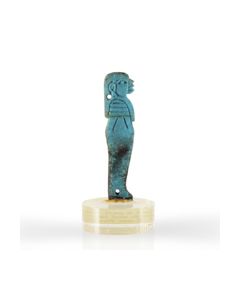 Appliqué of the Horus Son Imsety from Faiyum
Appliqué of the Horus Son Imsety from FaiyumMade of nice turquoise faience. Protective god responsible for the liver of a deceased. From the family of Lawrence of Arabia.
Price: on request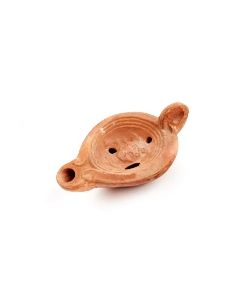 Roman imperial oil lamp with Hermes
Roman imperial oil lamp with HermesFrom the German collection Becker, in this for 3 generations.
Price: on request Appliqué of the Horus Son Imsety
Appliqué of the Horus Son ImsetyRare variety with wooden core and gilded linen. Protective god responsible for the liver of a deceased. From the family of Lawrence of Arabia.
Price: on request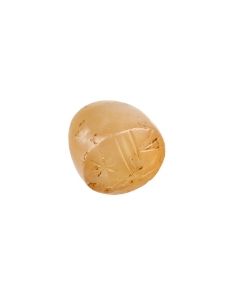 Neo-Babylonian stamp seal with religious scene
Neo-Babylonian stamp seal with religious sceneConical seal made of snowy chalcedony. The scene shows a praying man in front of an altar or symbols for the gods Ishtar and Shamash. Canonical piece for an educational collection.
Price: on request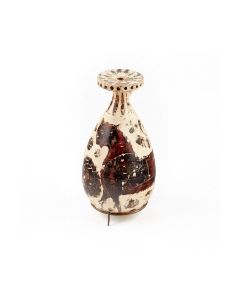 Corinthian alabastron with lion
Corinthian alabastron with lionLarge piece without any damage, rare preservation for an object of this size. Very impressive.
Price: on request Egyptian frog lamp from very old German collection
Egyptian frog lamp from very old German collectionThe frog lamps developed in Egypt close to Abydos. For the Egyptians, the frog symbolized birth and resurrection, this symbolism was also adapted by the early Christians. From the German collection Becker, in this for 3 generations.
Price: on request Neolithic flint sickle
Neolithic flint sickleHalfmoon shaped blade with fine edges. Nice and typical example for this neolithic type of tool.
Price: on request Small Etruscan plate
Small Etruscan plateUnusual decoration for a plate of this type. From an old German collection, acquired in the 1960s.
Price: on request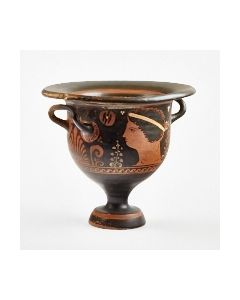 Greatly preserved Apulian bell krater
Greatly preserved Apulian bell kraterLarge vase in great condition. Used for watering down wine in Ancient Greece. From old German collection.
Price: on request Pair of earrings from Luristan
Pair of earrings from LuristanThe earrings date to the early Iron Age of Luristan. The type of jewellery is rare for this region.
Price: on request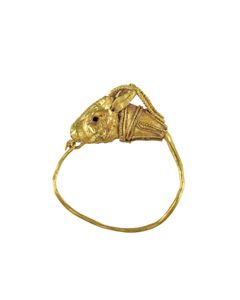 Hellenistic gold earring with antelope head
Hellenistic gold earring with antelope headEar pendant with plastically modeled head of an antelope. The elaborately made head is typical for hellenistic gold jewellery.
Price: on request Cylinder Seal from the late Uruk period
Cylinder Seal from the late Uruk periodSmall seal made of appealing igneous rock. The engraved wave pattern is typical for the late Uruk period of Mesopotamia.
Price: on request Celtic fibula
Celtic fibulaRare fibula from the La Tène culture with beautiful enamel inlays. The main material is well preserved for an iron fibula.
Price: on request Neo-Assyrian cylinder seal with preserved bronze setting
Neo-Assyrian cylinder seal with preserved bronze settingFantastic and rare example for a cylinder seal in its original setting. From the reign of Tiglath-Pileser III in the 8th cent. BC.
Price: on request Two Near Eastern weapon points
Two Near Eastern weapon pointsGroup of two bronze points for small spears or large arrows from the Bronze or Early Iron Age. With a nice green patina.
Price: on request Roman surgical probe made of silver
Roman surgical probe made of silverThe so-called specillum was standard issue for roman doctors. Similar probes are still in use today. Ancient surgical instruments made of silver are extremely rare.
Price: on request Scaraboid from the Middle Kingdom
Scaraboid from the Middle KingdomThe stamp shows hieroglyphs with a title for the king of Upper and Lower Egypt. This scaraboid is described in the catalogue of Irène Gautier-Vodoz.
Price: on request Egyptian faience ring showing Bes and Taweret
Egyptian faience ring showing Bes and TaweretThe finger ring with its scene on the plate must have served a protective function for an expectant mother. New Kingdom, approx. 1550 to 1070 BC.
Price: on request

